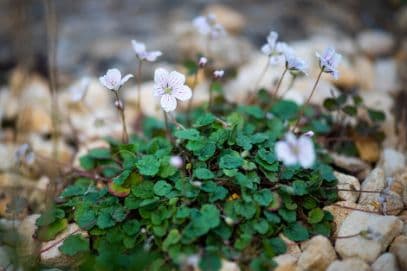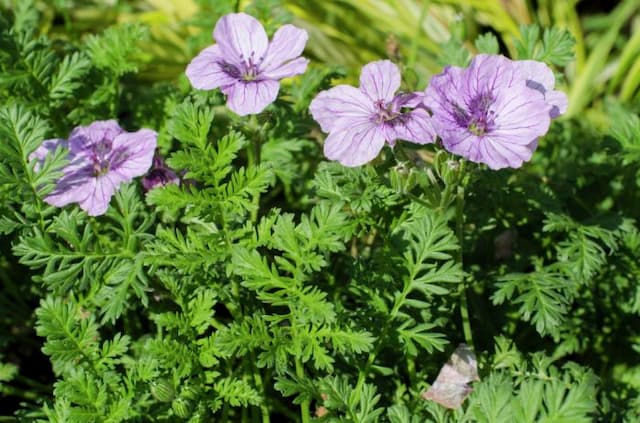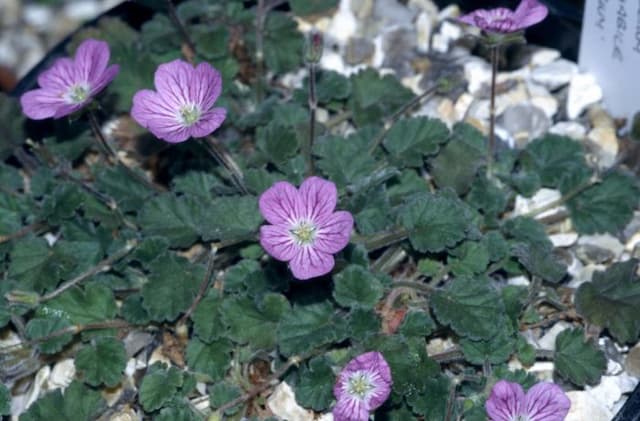Cranesbill Geranium Blue Sunrise = 'Blogold' (PBR)
![cranesbill [Blue Sunrise]](/_next/image?url=https%3A%2F%2Fplants-admin.emdemapps.com%2Fimages%2Fplants%2F%2Fimages%2F604b638d45948.png&w=3840&q=75)
ABOUT
The Geranium Blue Sunrise, commonly known as the 'Blogold', is a vibrant and captivating perennial plant. This Geranium variant is most noted for its stunning foliage and blossoms. The leaves are of an attractive, deeply cut form that typically displays a vivid green hue with hints of gold, especially vibrant when the leaves first emerge. As the seasons progress, this gold tonality can deepen, adding a warm contrast against the greenery. The flowers of the Geranium Blue Sunrise make a striking display with their bright, intense blue petals. The blooms have a round shape, with each petal delicately veined and radiating from the center where a cluster of tiny, darker bluish-purple stamens contrast prettily against the lighter petals. These flowers are known for their long-lasting presence, often continuing to provide color and interest throughout the growing season. Overall, the Geranium Blue Sunrise presents a harmonious blend of colorful foliage and eye-catching blooms that contribute to its popularity in gardens and landscape design. The plant has a bushy, mounding habit, giving it a lush, full appearance that can serve as a focal point in a garden bed or as part of a border. Its visual appeal is enhanced by its propensity to attract pollinators, which adds to the dynamic nature of the display it provides.
About this plant
 Names
NamesSynonyms
Cranesbill, Hardy Geranium.
Common names
Geranium Blue Sunrise = 'Blogold' (PBR).
 Toxicity
ToxicityTo humans
Geraniums, including the Geranium Blue Sunrise, are generally not considered highly toxic to humans. However, if ingested, they could potentially cause minor gastrointestinal irritation, including nausea, vomiting, or diarrhea. It's always best to exercise caution and keep plants out of reach of children who might accidentally consume plant parts.
To pets
Geraniums are known to be toxic to pets, particularly to dogs and cats. If a pet ingests part of a geranium plant, it could experience symptoms such as vomiting, diarrhea, depression, anorexia, and dermatitis. In severe cases, geranium ingestion might lead to more serious health concerns. If you suspect your pet has ingested geranium, it's important to contact your veterinarian promptly.
 Characteristics
CharacteristicsLife cycle
Perennials
Foliage type
Deciduous
Color of leaves
Varied
Flower color
Blue
Height
18 inches (45 cm)
Spread
24 inches (60 cm)
Plant type
Herb
Hardiness zones
5
Native area
Mediterranean
Benefits
 General Benefits
General Benefits- Attractive Flowers: Geranium Blue Sunrise boasts vibrant, colorful blooms that add aesthetic appeal to gardens and landscapes.
- Drought Tolerance: It is relatively resistant to periods of drought, making it suitable for water-wise gardening.
- Easy Maintenance: The plant is low-maintenance, requiring minimal care and is ideal for beginner gardeners or those with limited time.
- Pest Resistance: It has natural resistance to many common garden pests, reducing the need for chemical treatments.
- Heat Tolerance: Geranium Blue Sunrise can tolerate high temperatures, making it a good choice for hot climate zones.
- Long Flowering Season: It has a prolonged blooming period, providing color and interest for much of the growing season.
- Attracts Pollinators: The flowers attract bees and butterflies, which are beneficial for pollination in the garden.
- Versatility: The plant is suitable for a variety of garden settings, including beds, borders, and containers.
- Soil Adaptability: It can thrive in a range of soil types, although it prefers well-draining soil.
- Fast Growth: Geranium Blue Sunrise has a rapid growth rate, quickly filling in garden spaces and providing coverage.
 Medical Properties
Medical Properties- This plant is not used for medical purposes
 Air-purifying Qualities
Air-purifying QualitiesThis plant is not specifically known for air purifying qualities.
 Other Uses
Other Uses- Art and Craft Projects: Geranium petals can be used in art projects such as pressed flower crafts or potpourri, adding a splash of color and a subtle fragrance.
- Natural Dyes: The blossoms of the Geranium can be used to create natural dyes for fabrics or paper, resulting in beautiful, soft colors.
- Garden Design: The Geranium can serve as a border plant or groundcover, offering both function and aesthetic appeal with its attractive foliage and blooms.
- Companion Planting: Planting Geraniums in vegetable gardens can help deter certain pests, making it a natural companion plant.
- Edible Decorations: The flowers of the Geranium are edible and can be used as a decorative, colorful garnish on salads or desserts.
- Photography Subject: Due to its vivid hues, Geraniums serve as excellent subjects for botanical photography and garden portfolios.
- Floral Arrangements: The vibrant blooms of the Geranium can be used in cut flower arrangements, adding long-lasting color to bouquets.
- Teaching Tool: The Geranium can be featured in educational settings, like schools or botanical workshops, illustrating plant growth and development.
- Perfumery: While not its primary use, Geranium scents can be captured in homemade potpourris or natural perfumes.
- Erosion Control: The Geranium's root system can help to stabilize soil and prevent erosion in sloped gardens or areas with loose soil.
Interesting Facts
 Feng Shui
Feng ShuiThe Geranium is not used in Feng Shui practice.
 Zodiac Sign Compitability
Zodiac Sign CompitabilityThe Geranium is not used in astrology practice.
 Plant Symbolism
Plant Symbolism- Balance: Geraniums often symbolize balance due to their ability to harmonize various aspects of one's life.
- True Friendship: They are thought to represent close and positive relationships, and giving a geranium can signify a genuine bond between friends.
- Health: Geraniums are sometimes associated with health and vitality, reflecting a wish for the well-being of the recipient.
- Foresight: With geraniums having a long blooming season, they can symbolize the capacity to foresee events, promoting wisdom and insight.
- Unity: The diverse varieties of geraniums are seen as a sign of coming together of various elements, signifying unity and togetherness.
 Water
WaterHardy Geraniums, including the Geranium Blue Sunrise, require moderate watering. Typically, they need water when the top inch of soil feels dry to the touch, which might be about once or twice a week depending on your climate and the time of the year. Provide them with about one inch of water each time you water, which equates to approximately half a gallon for an outdoor plant of average size. It's crucial to avoid overwatering, as this can lead to root rot. During the winter, reduce watering to a minimum as the plant's water needs decrease.
 Light
LightHardy Geraniums like the Geranium Blue Sunrise thrive in a spot with full to partial sunlight. They can tolerate several hours of direct sunlight but also perform well with light dappled shade, especially in hotter climates. The best spot for this geranium would be somewhere it can enjoy morning sunlight and then be protected from the intense heat of the afternoon sun.
 Temperature
TemperatureThe Geranium Blue Sunrise is fairly cold-hardy and can tolerate temperatures as low as 20 degrees Fahrenheit but prefers to grow in conditions between 65 to 75 degrees Fahrenheit for optimal growth. However, it is important to protect the plant from frost and to ensure that it's not exposed to prolonged temperatures below freezing. Conversely, extreme heat above 90 degrees Fahrenheit can also stress the plant.
 Pruning
PruningPruning Geranium Blue Sunrise helps maintain a compact shape and promotes vigorous growth. Prune lightly throughout the growing season to remove faded flowers and encourage more blooms. A more thorough pruning should be done in early spring or after the first frost to remove any dead or diseased foliage and to shape the plant. Pruning too often or too drastically can reduce flowering, so practice moderation.
 Cleaning
CleaningAs needed
 Soil
SoilThe best soil mix for Hardy Geranium 'Blue Sunrise' should be well-draining and fertile. A mix of garden soil, peat moss, and perlite or coarse sand in equal parts is ideal. The soil pH should be slightly acidic to neutral, around 5.8 to 7.2.
 Repotting
RepottingHardy Geranium 'Blue Sunrise' should be repotted every 2 to 3 years to refresh the soil and accommodate root growth. It's best to repot in early spring before active growth begins.
 Humidity & Misting
Humidity & MistingHardy Geranium 'Blue Sunrise' prefers moderate humidity levels but is quite adaptable. It does not require high humidity and performs well in average home or garden humidity conditions.
 Suitable locations
Suitable locationsIndoor
Place Hardy Geranium 'Blue Sunrise' near bright light; water when soil dries.
Outdoor
Plant in partial sun, ensure good drainage, and space 30cm apart.
Hardiness zone
Hardy Geranium 'Blue Sunrise' is suitable for USDA zones 5-8.
 Life cycle
Life cycleGeranium Blue Sunrise, often known as Cranesbill, begins its life cycle when seeds are sown or cuttings are taken, usually in the spring. These germinate or root within weeks, and the young plants quickly form rosettes of foliage. As temperatures warm, Cranesbill enters a vegetative growth stage where stems elongate, leaves mature, and the plant's root system expands. The flowering stage follows, typically in late spring to early summer, when it produces vibrant blue flowers prized for their beauty. After pollination, the plant develops seed pods that eventually burst, dispersing seeds for the next generation. In late autumn, the Cranesbill dies back to its hardy rootstock, going dormant over winter to conserve energy for the next growing season.
 Propogation
PropogationPropogation time
Spring-Early Summer
The Geranium, specifically the Geranium 'Blue Sunrise', is often propagated via stem cuttings. This method is popular due to its simplicity and high success rate. To propagate, select a healthy, non-flowering stem and cut a 4 to 6 inch (about 10 to 15 cm) length, just below a leaf node, using a sharp, sterilized blade. Remove the leaves from the bottom half of the cutting to prevent rot. Dip the cut end in rooting hormone to encourage root development. Plant the cutting in a pot filled with a moistened mix of perlite and peat, inserting the stem about 1.5 inches (about 4 cm) deep into the soil. Place the pot in a warm, well-lit area, avoiding direct sunlight, and maintain the moisture level. Roots will typically form within a few weeks, after which the plant can be gradually acclimated to normal growing conditions.









